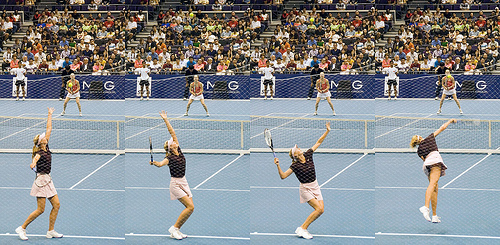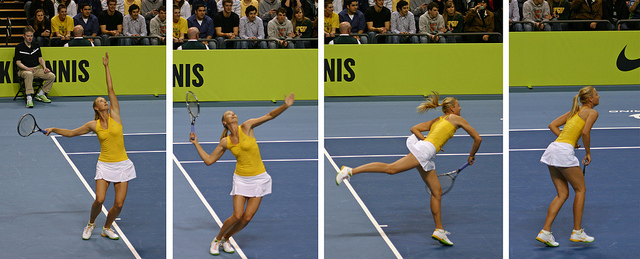Maria Sharapova’s serve technique is known for a motion that once led her to win Wimbledon at 17 years old against Serena Williams. Sharapova’s serve motion at that time was graceful, fluid and very relaxed which allowed her to deliver a very powerful and accurate serve.
Unfortunately, over a period of several years, she began to modify her serve motion into more of an abbreviated motion which threw off the natural timing of the stroke. This article will discuss the Maria Sharapova serve technique and it’s evolution.
Maria Sharapova Serve: Her Current Technique
Erratic. Unpredictable. Unreliable. These are words that describe a person with bipolar disorder. These people have wild mood swings that make them extremely happy, angry or dramatic, or sad, unenergetic or apathetic. When they swing over to the manic phase, they have the potential to be very productive.
But then they cycle over to the depressive phase and fail to get anything done. Patients suffering from this condition usually weren’t always this way. There was a stressor in their lives that triggered a tendency for them to develop the disease.
How is this related to the Maria Sharapova serve?
Sharapova, as you will recall, was a highly talented prodigy who came from Siberia to the United States to train at the Nick Bollettieri Tennis Academy. She showed a tremendous attitude toward competing and practicing. She worked very hard to develop powerful strokes that would enable her to play the most aggressive kind of game.
She was also blessed with great height and long limbs. This gave her great leverage and allowed her to develop a powerful serve. The big serve propelled her to three grand slam titles by the age of 21. But then, a nasty shoulder injury wrecked her serve. As it was the foundation of her game, the rest of her game deteriorated along with it. Her confidence suffered and her results plummeted.
Rebuilding Sharapova’s Serve
With hard work and determination, Sharapova kept trying to retool her game by rebuilding her serve. But the damage had already been done. As hard as she tried, it was just not the shot it once was. Because she practiced so hard and never stopped fighting, there have been periods of brilliance. Recently, she re-entered the top 10 by reaching the French Open semi-finals and the Wimbledon finals. But in both matches, the serve deserted her again. She committed double faults and was just not able to pressure her opponent right away. She could get away with a poor serving day against a lesser opponent, but in the late rounds of a grand slam, there was no such thing. The Sharapova serve continues to suffer from bipolar disorder.
Maria Sharapova’s Serve in 2004
When Sharapova claimed her first grand slam title at Wimbledon in 2004, she was only 17 years old. Even more impressively, the players she faced in the final two rounds were Lindsay Davenport and Serena Williams. Both had won Wimbledon before and both were known for their extreme groundstroke power and serving supremacy. Somehow, Sharapova was able to match them and beat them. She relied heavily on her serve to earn free points and dictate a lot of the rallies.
The Sharapova serve is preceded by a very elaborate and consistent ritual. She turns her back to her opponent and adjusts her strings. Then she walks up to the baseline, asks for the ball and takes a few skips. She chooses the ball she wants to serve with and puts the other one in her pocket. She dribbles the ball a few times with her racket and then catches it with her left hand. She looks at where she wants to put the ball and then tucks her hair behind her ears.
Then she adapts her service stance and bounces the ball two or three times from about head height. After all this, she finally commences her service motion. You would think that with such a consistent ritual there would be some semblance of reliability with her serve. In the past there definitely was. But presently, despite all of this, her serve is as moody as ever.
Sharapova Serve Technique
When it was a reliable weapon, commentators were effusive in their praise for the technique of the Sharapova serve. Like all great strokes, it begins with the proper grip. She uses the continental grip and holds the ball with her left hand, which at the same time supports the throat of her racket. Her feet are spaced body-width apart and her weight is on her back foot which is parallel to the baseline. The front foot is pointing toward the right net post.


She begins the motion by taking the racket back in a circular loop as she turns her shoulders and tosses the ball. The way she took her racket back is the most often modified part of her swing. When she first developed her injury, she abbreviated her take back and lifted the racket almost straight up to the trophy position.
Maria Sharapova’s Attempt to Model the Abbreviated Serve
This is a technique that Andy Roddick uses. But Sharapova lacks the whippy and snappy quality or Roddick’s motion. She does not have the power to coil and uncoil very quickly. She is better off generating momentum by taking a long swing. In short, this technique robbed her of power. She has since gone back to the fuller circular motion but she also experimented with variations in between. Her present circular take back is still not quite as full as her earlier pre-injury days.
Sharapova tosses the ball and transfers weight onto the front foot. The toss is quite high, since she is tall and has long arms. Still, it could be just a little lower to help her with consistency. This is one part of her serve which she never changed. When she used the shorter take back, she had to wait longer for the ball to drop to hitting height, stalling her momentum and inhibiting her power.
Another aspect of the toss that could be improved is that the tossing arm extends more out to the front than to the side. This is good in the sense that it will ensure the ball being tossed in front of her body. But it also prevents her torso from coiling more fully.
Sharapova Serve: Knee Bend & Coil
The next phase of the Sharapova serve sees her knees bend and shoulders tilt. The shoulders rotate further than the hips. With her weight now on her front foot, her left hip moves forward. The forward swing then commences. She drives her legs upward and her racket is taken to the back scratch position. Her hips begin to uncoil. Her arm exaggerates the external rotation of the shoulder and this may have been one factor in the development of her injury. She rotates shoulder over shoulder as she drives upward to the ball.


Her racket is still pointing downward because her wrist is cocked back and her elbow bent. As she hits the ball, her hips and trunk rotate forward while her elbow extends. The forearm then pronates quickly to snap the racket head at the ball. Her ‘default’ service motion makes her hit the ball flat. If she had a more natural tendency to hit with spin, she wouldn’t double fault as much. Her shoulder injury has limited her ability to come around the side of the ball and slice it.
Sharapova Serve: Follow Through Phase
She has now decided to hit more kick serves but it is also not a natural shot for her. Her toss isn’t ideal and she isn’t flexible enough in the trunk to coil and uncoil for a really strong kick serve. She has to rely more on her arm motion to generate the spin. It doesn’t generate enough so her margin is still not as good as it should be.
The final phase of the Sharapova serve sees her follow through by pronating all the way and decelerating the racket. She lands well inside the baseline on her left foot in an arabesque position.
Sharapova Serve: Recovery Position
The flaw here is that she seems to be teetering on the verge of losing balance. Because she is so tall, it is difficult for her to recover to the ready position. At Wimbledon 2011, Petra Kvitova rifled her return so fast that after serving, Sharapova was forced to hit a lot of shots defensively and off balance.
From her history, we know that Sharapova is a woman who will never quit. She will keep working on her serve in order to cure it from the bipolar disease it has suffered for several years now. So for her fans, her recent results should provide encouragement that her future will still possibly be as bright as her past.
Learn to Hit a Forehand Like Roger Federer
If you want to jumpstart your forehand and play like the PROS, check out my 70+ page Tennis Ebook that will immediately show you how you can take your forehand to the next level.
The Modern Forehand Domination Ebook is guaranteed to improve your tennis technique, and increase power, topspin and accuracy of your tennis forehand!
Modern Tennis Forehand Ebook
Learn How to Hit a Forehand Like Federer, Nadal and Djokovic

